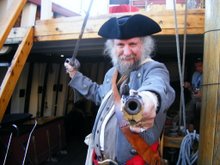Marauders. Plunderers. Bloodthirsty sea-thieves. Whatever their name, pirates have wreaked havoc on the high seas since waterway travel began. These seafaring scoundrels command attention in a major exhibit at the North Carolina Museum of History in Raleigh. Knights of the Black Flag explores the legacy of pirates, from ancient times to the present, through intriguing artifacts, legends and history that bring their ruthless adventures to life. The interactive exhibit is an exciting experience for all ages.
Knights of the Black Flag traces the history of piracy from ancient Egypt, Greece and Rome through today’s pirates in Somalia. Artifacts, some dating to the early centuries A.D., represent tangible links to a violent past. For example, a Roman amphora (storage jar) from southern Jordan may have been seized by ancient pirates on a ship in the Red Sea. Other artifacts speak to the Golden Age of Piracy, from 1689 to the 1720s. These include Queen Anne-style pistols and items discovered in the ruins of Blackbeard’s purported house in Bath. Objects related to modern-day piracy in Somalia include an AK-47, gas masks and knapsacks.
Showcasing many objects related to pirates, Knights of the Black Flag includes the largest collection of artifacts ever exhibited from the shipwreck believed to be Blackbeard’s flagship, Queen Anne’s Revenge. Legends surround another compelling artifact on loan from the Peabody Essex Museum in Salem, Massachusetts: the alleged skull of Blackbeard. The exhibit will be on view through January 3, 2010.
Sunday, March 29, 2009
Knights of the Black Flag
A new exhibition just opened at the North Carolina Museum of History - Knights of the Black Flag covers piracy through the ages, from Egypt to Somalia with an emphasis on Queen Anne's Revenge.
Wednesday, March 18, 2009
Six ways to Stop Piracy
Wired has a quick list of ways to stop piracy. This shows how much piracy has changed in the last 300 years. One of the ways is to move evasively (zig-zag) in the hopes of creating enough wake to swamp a pursuer. Just try that in a galleon. In fact, the only suggestion that would have worked in the Golden Age of Piracy is to hire some extra guards. They suggest Gurkhas who would make great guards in any century.
Wednesday, March 11, 2009
Captain Ron
Captain Ron surfaced recently on cable. This isn't exactly a pirate movie although it has some modern pirates in it. It is also light fun.
A family inherits a yacht and decides to go sailing the Caribbean. They hire a one-eyed sailor called Captain Ron to teach them how to handle the yacht. Ron (played by Kurt Russel) is crude and accident prone. He gets lost often, ending up on the wrong island. The head of the family (Martin Short) hates Ron from the beginning but the rest of the family takes to him.
At one point Ron produces some automatic weapons that he got from some guerrillas in exchange for transporting them to a different island. He explains that they needed the weapons in case they were attacked by pirates, "You know, Pirates of the Caribbean." Martin suggests that Ron has spent to much time at Disney World and throws the guns overboard.
Ron wears an eyepatch because his glass eye freaks out some people. At one point he looses the eye and goes crawling after it as in PotC.
Eventually of course, they do meet up with pirates and have to use the skills that Ron taught them to save their lives.
Not a very deep movie but a bit of light fun.
A family inherits a yacht and decides to go sailing the Caribbean. They hire a one-eyed sailor called Captain Ron to teach them how to handle the yacht. Ron (played by Kurt Russel) is crude and accident prone. He gets lost often, ending up on the wrong island. The head of the family (Martin Short) hates Ron from the beginning but the rest of the family takes to him.
At one point Ron produces some automatic weapons that he got from some guerrillas in exchange for transporting them to a different island. He explains that they needed the weapons in case they were attacked by pirates, "You know, Pirates of the Caribbean." Martin suggests that Ron has spent to much time at Disney World and throws the guns overboard.
Ron wears an eyepatch because his glass eye freaks out some people. At one point he looses the eye and goes crawling after it as in PotC.
Eventually of course, they do meet up with pirates and have to use the skills that Ron taught them to save their lives.
Not a very deep movie but a bit of light fun.
Tuesday, March 3, 2009
River Pirates
I've been reading up on river pirates. They occupy a big place in media peaking with a segment in How the West Was Won. Like most stories about the wild west, river piracy was never as common as popular fiction would have it. On the other hand, it did exist and its extent is hard to judge because of the dangers of river traffic.
River piracy flourished in the Ohio and Mississippi Rivers in the mid-18th century. During this period there was a lot of one-way traffic going down the rivers, mainly on flatboats. These were large rectangular rafts with sides and, often, some sort of cabin or shelter. They were used to float cargo down river. When they reached their destination they would break up the flatboat and sell it as lumber.
Most flatboats traveled in convoys. It was the loners that attracted pirates.
Unlike an open-sea pirate who needed a ship, river pirates only needed a boat or two. They didn't try to live on their boats. They either lived on islands or along the river banks. From there they could watch for targets.
People who became river pirates were either ruthless whites or escaped slaves (or both). They usually had some sort of arrangement with a local merchant or two who would accept merchandise without questioning the source.
River piracy was only possible during the early years of colonization. As cities and towns grew up along the rivers there was no place for the pirates to hide and the rivers became relatively safe.
River piracy flourished in the Ohio and Mississippi Rivers in the mid-18th century. During this period there was a lot of one-way traffic going down the rivers, mainly on flatboats. These were large rectangular rafts with sides and, often, some sort of cabin or shelter. They were used to float cargo down river. When they reached their destination they would break up the flatboat and sell it as lumber.
Most flatboats traveled in convoys. It was the loners that attracted pirates.
Unlike an open-sea pirate who needed a ship, river pirates only needed a boat or two. They didn't try to live on their boats. They either lived on islands or along the river banks. From there they could watch for targets.
People who became river pirates were either ruthless whites or escaped slaves (or both). They usually had some sort of arrangement with a local merchant or two who would accept merchandise without questioning the source.
River piracy was only possible during the early years of colonization. As cities and towns grew up along the rivers there was no place for the pirates to hide and the rivers became relatively safe.
Subscribe to:
Posts (Atom)

